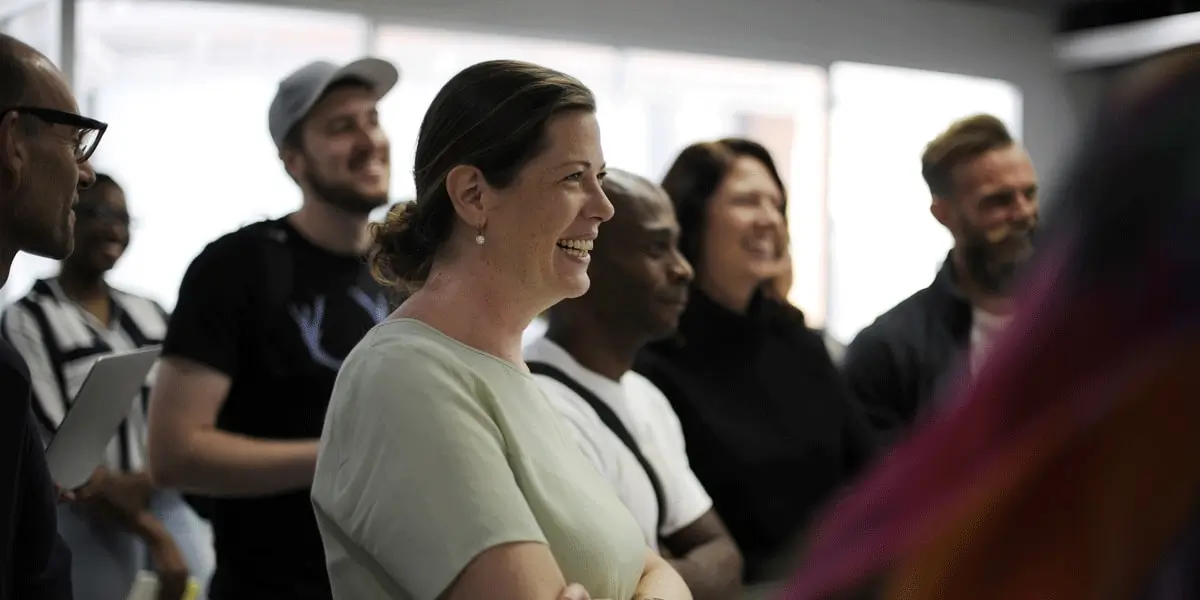Design Thinking has become an extremely popular approach to problem-solving—not only among designers, but across all areas of business. A Design Thinking workshop will spark innovation, foster a user-centric mindset, and get cross-functional teams working together to design a great product.
Workshop facilitation is an important skill for any designer, but it can be tricky to master. In this guide, we’ll show you how to run an effective design thinking workshop.
By the end, you’ll be ready to take your colleagues (or clients) through the entire Design Thinking process, equipping them with the tools they need to come up with innovative strategies and ideas.
Here’s what we’ll cover:
- What is a Design Thinking workshop?
- Why run a Design Thinking workshop?
- How to run a Design Thinking workshop (step-by-step)
- What next?
Ready to run an unforgettable Design Thinking workshop? Let’s go!
1. What is a Design Thinking workshop?
A Design Thinking workshop is a hands-on, activity-based session built around the Design Thinking process. Most often, these are conducted in person, but you can certainly adapt and conduct a remote Design Thinking workshop.
It can last two hours, two days, or even a full week—it all depends on the context and the goals at hand.
Based on the five phases of Design Thinking, a Design Thinking workshop focuses on:
- Empathy: Getting to grips with a real user problem and building empathy for the target users / customers.
- Ideation, innovation, and problem-solving: Generating as many ideas and potential solutions as possible.
- Prototyping and testing: Building low-fidelity prototypes of the ideas generated, ready for testing on real or representative users.
Design Thinking workshops are all about collaboration and problem-solving. As a designer, you might hold a Design Thinking workshop with your direct team in order to tackle a tough design challenge you’ve been struggling with. However, Design Thinking workshops aren’t just for designers; they are also increasingly used to teach professionals how to innovate and problem-solve. Throughout your design career, you might find yourself running Design Thinking workshops for clients—going into different organizations and showing them how they can apply Design Thinking to their own business challenges.
Indeed, Design Thinking can be applied to all areas of business, and a Design Thinking workshop can therefore be useful for everyone—from marketing, product, and sales, right through to the C-level. Let’s consider the benefits of a Design Thinking workshop in more detail.
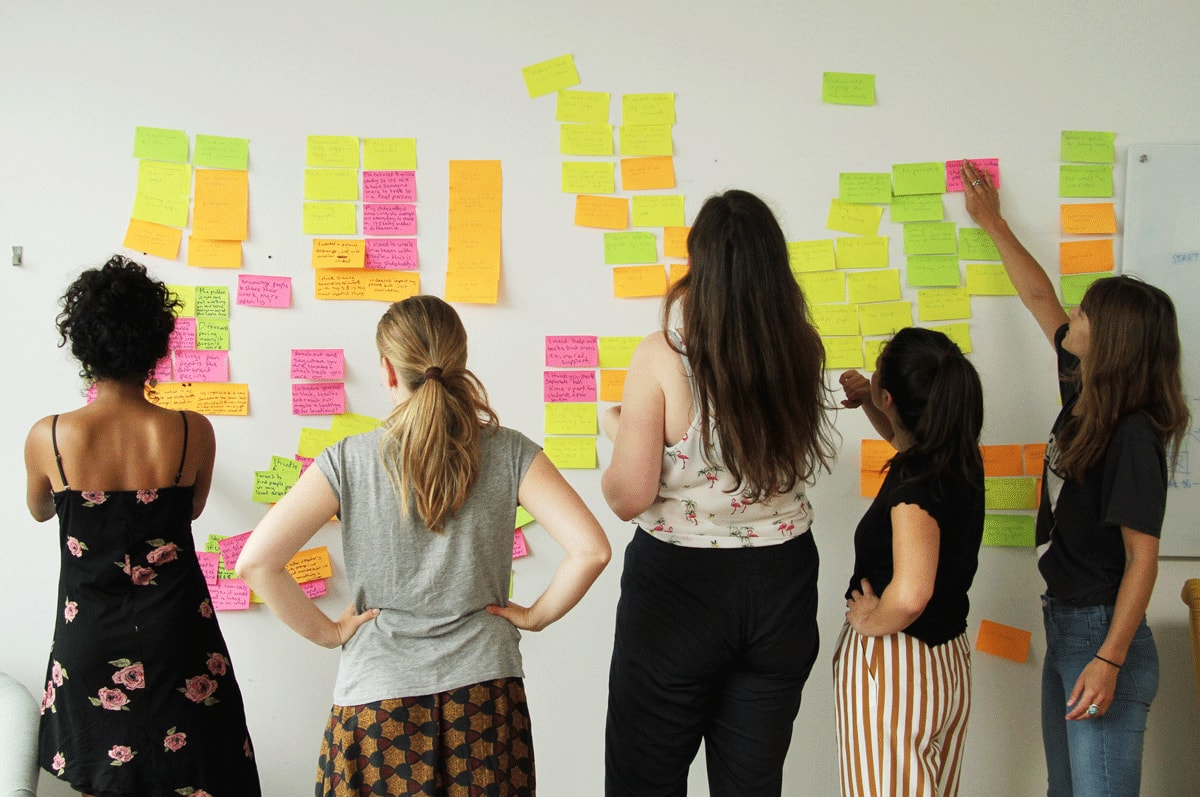
2. Why run a Design Thinking workshop?
As a designer, incorporating Design Thinking into your process will help you to quickly come up with viable, user-centric solutions—ultimately resulting in a quicker time-to-market, improved customer retention, significant cost savings, and a great ROI.
Design Thinking workshops enable you to spread this value across your organization (or your client’s organization). Here are some of the benefits at a glance:
- Teach people how to problem-solve: Problem solving is a key skill that everyone should master. A Design Thinking workshop teaches problem solving in action, giving the workshop participants an approach they can apply to almost any challenge in any area of their lives.
- Foster innovation and teamwork: The very essence of Design Thinking lies in collaboration and thinking outside the box. As a designer, these things are second nature to you; for others, it might not come so easily. A Design Thinking workshop breaks down silos and shows participants how to challenge their assumptions—a recipe for innovation!
- Secure a competitive advantage: A Design Thinking workshop may result in groundbreaking solutions that ultimately set the company apart—but competitive products aren’t the only takeaway. Design Thinking workshops teach creative thinking, which is increasingly seen as a competitive advantage when applied at a strategic level.
“Most companies today have innovation envy. They yearn to come up with a game-changing innovation like Apple’s iPod, or create an entirely new category like Facebook. Many make genuine efforts to be innovative—they spend on R&D, bring in creative designers, hire innovation consultants. But they get disappointing results.
Why? We rely far too exclusively on analytical thinking, which merely refines current knowledge, producing small improvements to the status quo. To innovate and win, companies need design thinking.”
—Roger L. Martin,The Design of Business: Why Design Thinking is the Next Competitive Advantage (2009)
All these benefits aside, Design Thinking workshops are incredibly fun and engaging. They bring together a diverse group of people from different departments and provide a rare opportunity to get hands-on with the problem.
So how do you go about setting up and facilitating a Design Thinking workshop? Let’s find out.
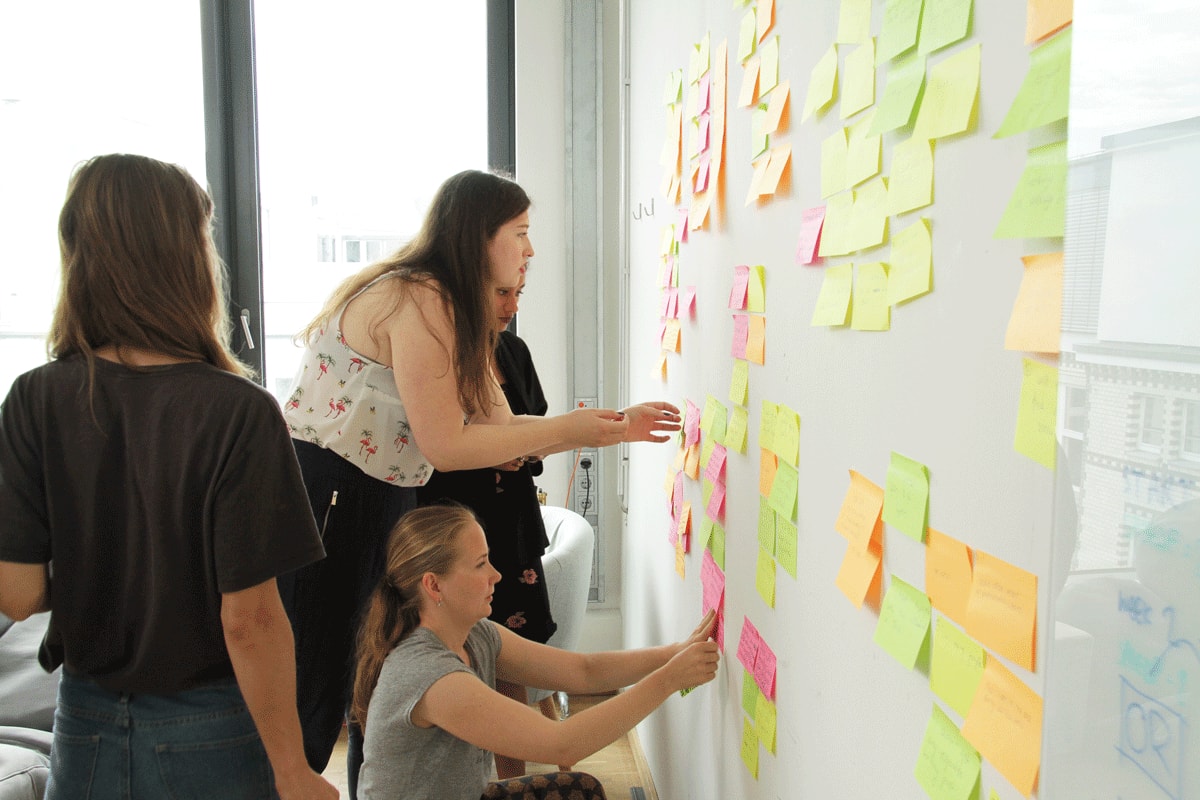
3. How to run a Design Thinking workshop: Step-by-step
Now we’ll go through all the necessary steps for running a Design Thinking workshop. We’ve divided this guide into two phases: how to plan and prepare for your Design Thinking workshop, followed by how to actually conduct the workshop.
Phase 1: Planning and preparation
To help with the preparation phase, we’ve put together a pre-workshop checklist (below). Further down, you’ll find more information to help you with each checklist item.
Pre-workshop checklist:
- Scope out the challenge and set workshop objective(s)
- Find a suitable location
- Plan the agenda (including time slots for each activity)
- Gather all necessary materials
1. Scope out the challenge and set objectives
There are many reasons you might hold a Design Thinking workshop; perhaps you need ideas for a new product, or maybe you’re looking for ways to improve an existing one. It could be that you need to come up with a drastic strategy for regaining consumer trust after a PR disaster! If you’re running a workshop for a client, perhaps the main purpose is to teach them about Design Thinking and how it can be applied to their business. In this case, you can still solve a real-world problem based on their product and industry.
Whatever the context, be clear on what the workshop should achieve. Let’s imagine you’re working for LoveFoundry, an online dating service. The goal of the workshop might be to come up with ways to improve the user experience for LoveFoundry customers.
For the purpose of your workshop, you’ll frame the challenge as a “how might we” question: How might we improve the user experience for LoveFoundry customers?
At the moment, this is a rather broad question. However, you’ve established the purpose of your Design Thinking workshop: to generate ideas for how to improve an existing digital product. Later on, you’ll narrow the design challenge down as part of the workshop itself.
2. Prepare the workshop location
Next, you need to create the optimal space for your workshop.
Design Thinking workshops should be dynamic and interactive, so it’s important that participants have plenty of room—especially when it comes to the prototyping stage. Ideally, you’ll have a separate table for all the materials and equipment (more on that in step three!).
Aside from comfortable seating and good lighting, you can create a relaxed environment by playing some background music. Another simple yet powerful touch is to position some thought-provoking artifacts around the room. If you’re running a workshop for a client, you might print display advertising campaigns from three of their biggest competitors, for example.
The purpose of a Design Thinking workshop is to get people thinking outside the box, so be sure to set up a space that invites creativity.
3. Plan your agenda
Now for the most crucial part: planning your workshop agenda. When tackling this somewhat tricky task, there are two golden rules to bear in mind:
- Don’t overfill your agenda.
- Keep it activity-based.
It might be tempting to cram in as much as possible, but the workshop will just end up feeling rushed—which is not conducive to creativity! Think about the time you have available and divide it up logically. Ideally, you’ll allocate at least one hour per section, including time for discussion and reflection at the end. You’ll also need to incorporate an introduction, an ice-breaker activity to get the group warmed up, and sufficient breaks throughout.
Another common error is to focus too heavily on presentations. A Design Thinking workshop should be largely activity-based; your participants need to be hands-on and engaged. The key is to deliver interesting, relevant content, followed by a practical exercise and then group discussion.
We’ll look at what to include in your workshop agenda in phase two of this guide a little further down.
4. Gather all necessary materials
With your agenda in place, you should now have a good idea of what you’ll need for the workshop.
Part of the workshop will be dedicated to building low-fidelity prototypes, for which you’ll need a good selection of materials. Opt for simple, everyday materials that everyone is familiar with—such as white copy paper, colored construction paper, sticky tape, marker pens, and Post-it notes.
It’s also a good idea to have a camera on-hand so you can document the workshop. This is extremely helpful when it comes to reviewing your workshop, and, if you’re running your workshop with clients, photos also make for a great souvenir.
With general preparation out of the way, let’s move on to phase two of our guide. In this section, we’ll explore your Design Thinking workshop agenda in more detail.
Phase 2: Executing your Design Thinking workshop
In phase one, we went through some general pointers to consider when devising the workshop agenda. Now we’re going to consider the agenda in more detail, going through all the elements that make up a successful Design Thinking workshop! We’ve also included time slots based on a 1-day workshop.
1. Introduction and briefing (15 minutes)
Start by welcoming everybody to the workshop and setting expectations. Some key points to include in your introduction are:
- Who you are (if you’re conducting a workshop with a client).
- The workshop objectives and the design challenge: e.g. To introduce the process of Design Thinking using a real-world design challenge: How might we improve the user experience for LoveFoundry customers?
- The workshop schedule.
This is also a good time to mention that you’d like to document the workshop by taking photos.
2. Ice-breaker activity (20 minutes)
It’s always a good idea to kick off the workshop with an ice-breaker. This will put everybody at ease before the real work begins!
Here are some fun ice-breaker activities you might like to use:
- One truth, two lies: Get everybody up on their feet and standing in a circle. Each person takes it in turns to tell one truth about themselves together with two lies. The rest of the group votes on which statement they think is true.
- One-word relay: The aim of the one-word relay is to construct a story as a group. You’ll all stand in a circle and take it in turns to add a few words to what the previous person has said. You should end up with a grammatically sensical yet completely random (and hilarious) story.
- Five-minute portraits: Give each participant a piece of paper and a felt-tip pen. The group has five minutes to doodle a portrait of another workshop participant of their choice. At the end, each person presents their portrait; can the rest of the group guess who it’s supposed to be?
For more inspiration, check out this list of 26 ice-breaker games and activities.
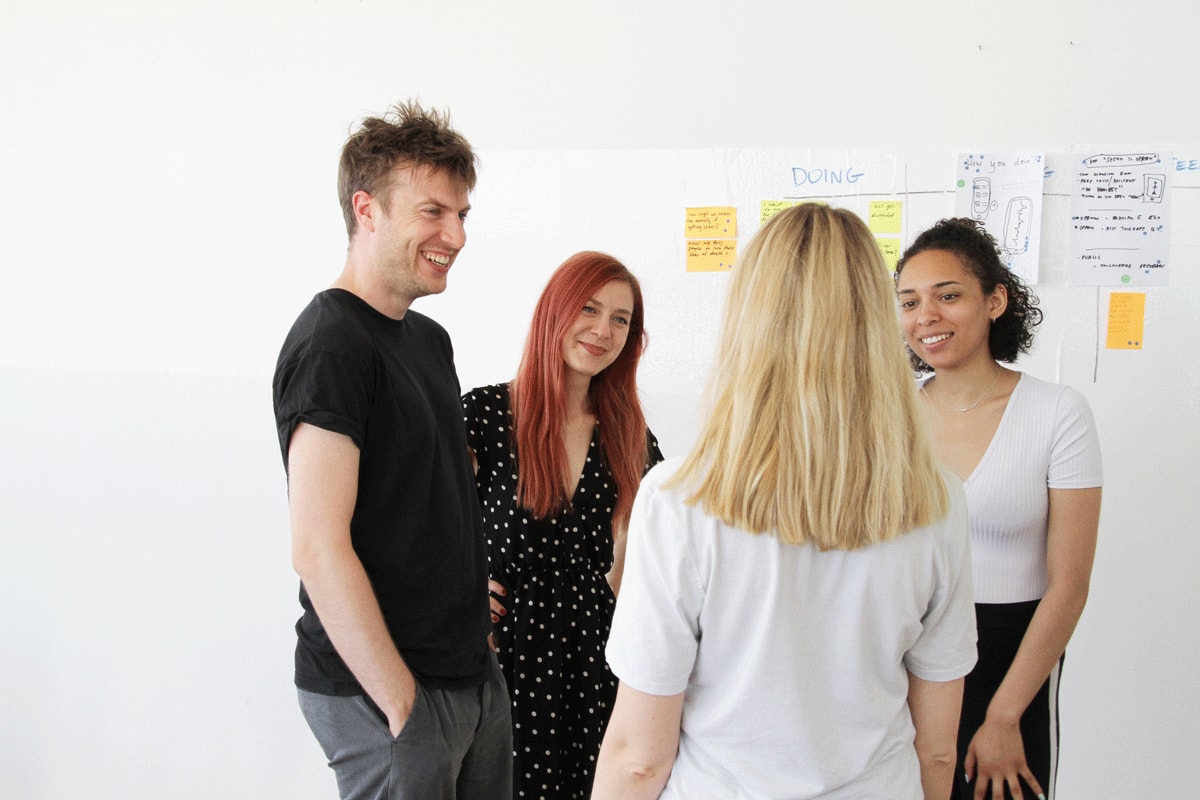
3. Introduction to Design Thinking (20 minutes)
If you’re conducting a Design Thinking workshop with clients or colleagues from other departments, you’ll need to get everybody up to speed on what Design Thinking actually is.
This can be a brief presentation covering the following points:
- A definition of what Design Thinking is. We’ve covered the fundamentals of Design Thinking in this guide.
- The five phases of Design Thinking, together with a quick explanation of each: Empathise, define, ideate, prototype, and test.
- The benefits of Design Thinking. This might be a good time to share some interesting stats—for example: teams that are applying IBM’s Design Thinking practices have calculated an ROI of up to 300%.
- A real-world Design Thinking case study, such as the Rotterdam Eye Hospital case.
By now, you’ve set the scene and put everybody at ease. This is a good point to break for ten minutes before diving into the first activity.
4. Building empathy for the user (1 hour)
Understanding your end user’s needs is the first step towards innovation—and that’s the first message you’ll deliver in your Design Thinking workshop.
For the empathise phase of the workshop, you’ll encourage participants to step into the user’s shoes and really think about what they need from the product. Continuing with the example of LoveFoundry, our imaginary online dating service, let’s consider how you might construct the empathise phase.
- Presentation (10 minutes): What is empathy? Why is it so important to design for the user first? You can find lots of information about empathy in Design Thinking here.
- Activity—conduct user research (10 minutes): Normally, the empathise phase consists of conducting research with actual users. For your Design Thinking workshop, ask your participants to pair up and take it in turns to play the user. Provide them with some starter questions, such as: How would you describe your most recent experience with online dating? How did the experience make you feel?
- Activity—create an empathy map (10 minutes): Each participant divides their page into four quadrants: “says”, “thinks”, “does”, and “feels”. Based on what they observed in the previous activity, they’ll fill in each quadrant with hypothetical (or direct) quotes and observations.
- Presentation of empathy maps (20 minutes): Ask each participant to briefly present their empathy map to the rest of the group.
- Reflection and discussion (10 minutes): As a group, discuss what you’ve learned so far. This is also a good time for questions.
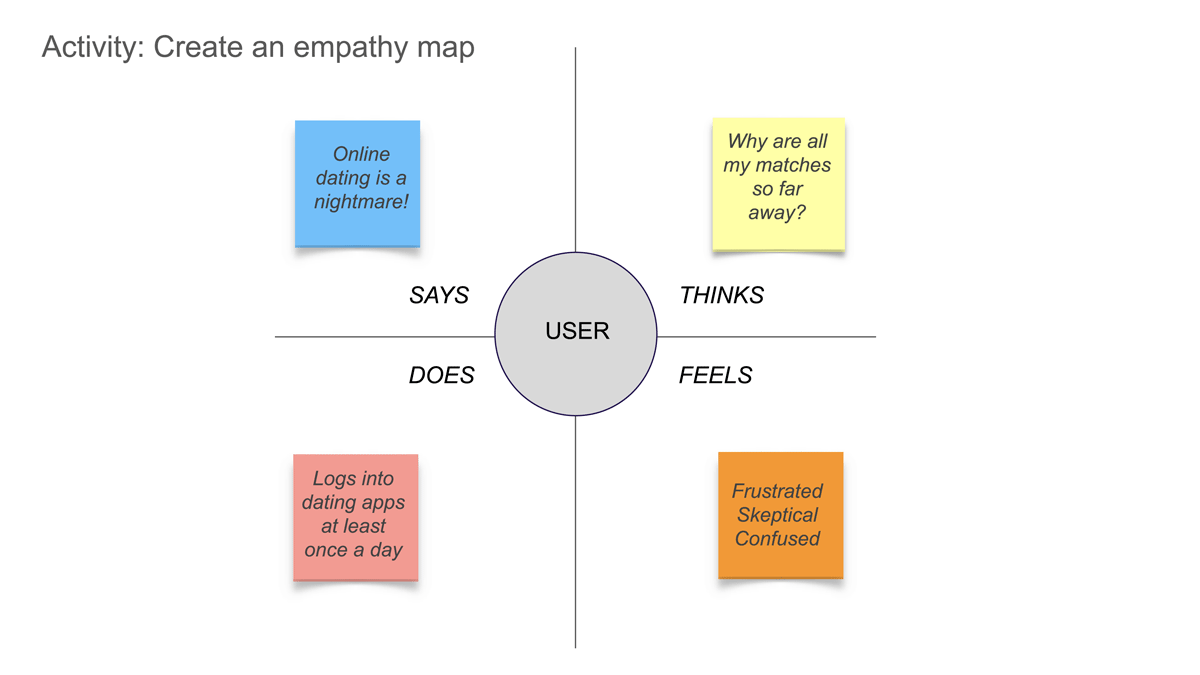
5. Define a problem statement (1 hour)
Next, you’ll move onto the define phase. This is where your participants will narrow down the broader design challenge (how might we improve the user experience for LoveFoundry customers?) to something more specific.
The define phase of your Design Thinking workshop might look something like this:
- Presentation (10 minutes): What is the define stage and why is it necessary? What is a meaningful problem statement? You can learn all about how to define a problem statement in this guide.
- Activity—craft a point of view (10 minutes): Based on their empathy maps from the empathise phase, ask participants to create a point of view statement. The point of view statement should include a specific user, a need, and an insight. For example: “A busy, middle-aged professional needs an easy way of meeting like-minded people in the local area. Safety is also an important factor.”
- Activity—reframe the problem as a “how might we” question (10 minutes): Now, participants will turn the user’s needs into a “how might we” question. For example: “How might we provide an easy, safe, online dating experience?”
- Presentation of problem statements (20 minutes): Ask each participant to share their problem statements and “how might we” questions, with a brief explanation as to why they decided to focus on this particular problem. You, the facilitator, will write each problem statement up on the board.
- Reflection and discussion (10 minutes): As a group, discuss what you’ve learned so far. Has everybody identified similar user needs, or is there lots of variety?
6. Ideation part 1: Generate ideas and potential solutions (1 hour)
The third phase in the Design Thinking process consists of ideation—coming up with ideas and potential solutions to solve the user’s problem.
Start by introducing an ideation technique of your choice. For this example, we’ll use the worst possible idea technique followed by a simple brainstorm. You can learn about different ideation techniques in this comprehensive guide to ideation in Design Thinking.
You might break the ideation phase up as follows:
- Presentation (5 minutes): What is ideation? What ideation technique will the group be using today, and how does it work? Provide a few examples to help them get started.
- Activity—worst possible idea (10 minutes): Using the “worst possible idea” technique, ask the group to spend around ten minutes coming up with “anti-solutions” to the problem they’re trying to solve.
- Activity—coming up with solutions (10 minutes): Having explored the opposite of what would be helpful to the user, it should now be easier to find potential solutions. Get the group to spend another ten minutes brainstorming as many ideas as possible. They can use words or sketches.
- Activity—sharing ideas and getting feedback (10 minutes): Ask participants to pair up and share their ideas. This step is all about gathering useful feedback: Are the ideas good? Why, or why not?
- Activity—refining your solution (10 minutes): Incorporating what they’ve learned about the user and the feedback they received on their initial ideas, it’s time for the Design Thinkers to pull everything into one single solution. For this activity, encourage participants to sketch out their solution rather than using words.
- Reflection and discussion (5 minutes): As a group, discuss what you’ve learned from the ideation phase so far.
7. Ideation part 2: User journey mapping (1 hour)
Now you’ll introduce a key UX design tool into the mix: user journey maps.
As explained by the Nielsen Norman Group, a journey map is a visualization of the process that a person goes through in order to accomplish a goal. In the second part of the ideation phase, you’ll get your participants to compile a series of user actions into a timeline. Then they’ll add desires and pain-points for each step in the user’s journey, based on the one solution they decided on previously. For this part of the workshop, participants will need plenty of Post-it notes and a large surface to work on—such as a table, wall, or whiteboard.
You can divide the journey mapping phase of your Design Thinking workshop into the following activities:
- Presentation (10 minutes): What is a user journey map? Why do we need to create one, and what steps are involved?
- Activity—define the activities and steps in the customer’s experience (15 minutes): Ask participants to write down all the steps they can think of that make up the user’s journey. For example: Downloads the app, creates an account, uploads a profile photo, browses through potential matches, receives a match, sends a message. For the last 5 minutes, participants should combine any steps that are too similar, narrowing it down to 8-15 steps.
- Activity—group the steps into phases (10 minutes): Participants will now group the steps from the last activity into phases, aiming for 3-7 phases in total. Phases should be labelled from the user’s perspective. For example: Getting started, browsing the app, interacting with other users, etc.
- Activity—adding goals and pain-points (15 minutes): Ask participants to come up with goals and pain-points that relate to each step in the user journey. Goals are what propel the user from one step to the next, while pain-points prevent the user from moving forward. For example: The step “browses through potential matches” could be propelled by the user goal of wanting to meet new people. A pain-point could be that they don’t find any suitable matches in the local area.
- Sharing user journey maps, reflection and discussion (10 minutes): At the end of the ideation phase, put ten minutes aside for presenting and reflecting on all the user journey maps created.
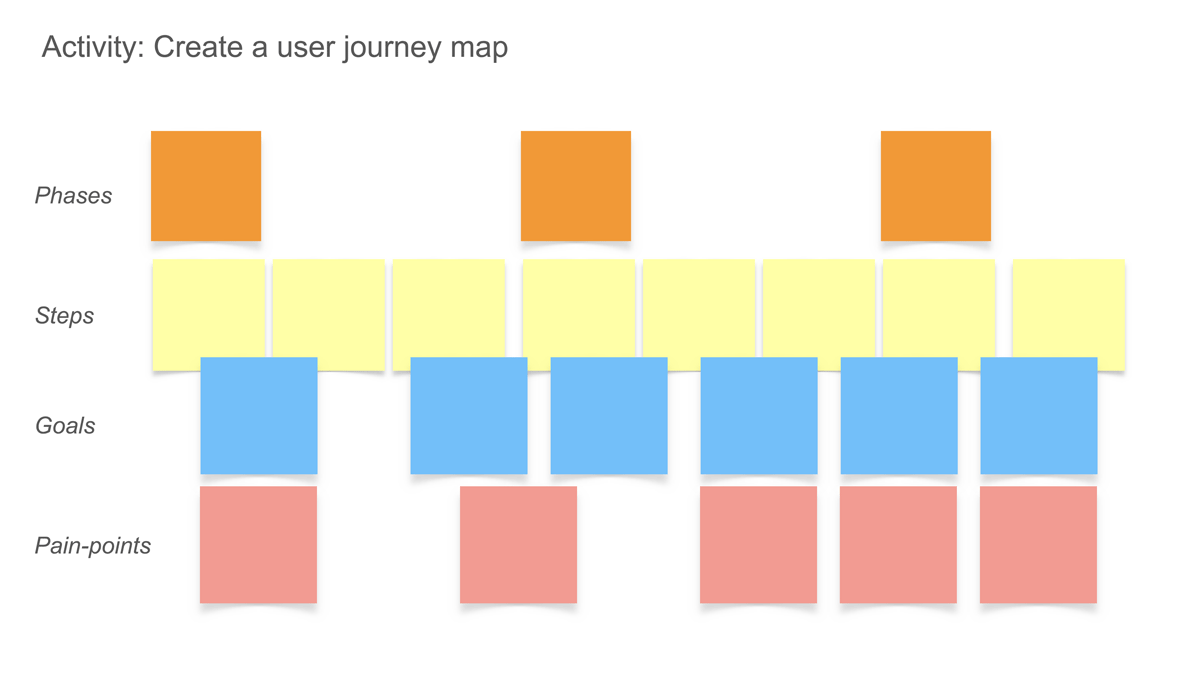
8. Prototype and test ideas (1 hour)
Now for the fun part: building prototypes and testing ideas!
In this section of the workshop, participants will turn the steps from their user journey maps into digital screens for an app. They’ll then gather feedback from the rest of the group. Here’s an example of how you might run the prototyping and testing phase:
- Presentation (5 minutes): A brief introduction to prototyping and the materials needed for the following activities.
- Activity—create mobile screens (15 minutes): For each step in the user journey, participants will sketch out the user interface (i.e. the mobile screen) that would be needed for this step. Encourage participants to use one piece of paper per screen; this way, they won’t need to start over completely if one goes slightly wrong.
- Activity—add functionality to mobile screens (15 minutes): Now participants will turn their sketches into low-fidelity paper prototypes by adding functionality. Using Post-it notes, they’ll describe the functionality of each button; for example “adds item to basket”.
- Activity—user testing (15 minutes): Ask participants to spend some time with each member of the group, walking them through their designs and gathering feedback. Recommend using a feedback grid with the following quadrants: what worked, what could be improved, questions, and ideas.
- Activity—decide on a winning approach (10 minutes): Once the user testing round is complete, stick all design solutions up on the wall. As a group, you’ll now decide on a winning approach. Ask each participant to place a sticker on the idea they think is best.
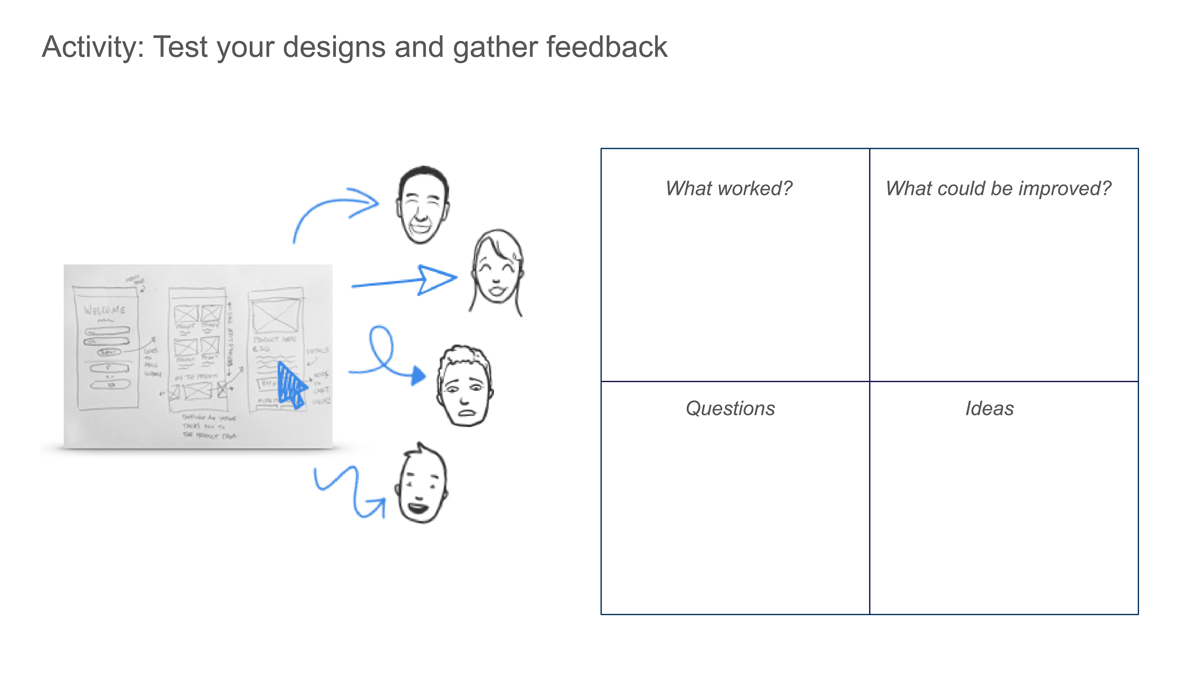
9. Debrief and outline next steps (15 minutes)
Round off your Design Thinking workshop with a quick debrief. Participants should come away with an understanding of how Design Thinking can be used in the real world, so explain what would usually happen next—turning paper prototypes into wireframes and, eventually, clickable prototypes to be tested on real users, for example.
Dedicate the last ten minutes or so to reflection and discussion. Ask your Design Thinkers how they enjoyed the workshop and what they’ve learned. Was there anything that surprised them? What will they take away with them?
4. Running a Design Thinking workshop: What next?
Congratulations: you’ve just conducted an engaging, informative, and extremely valuable Design Thinking workshop! So what next?
If you are new to the world of workshop facilitation, you can apply some Design Thinking principles to the process itself. Take a user-centered approach and ask your participants for feedback. A great way of gathering feedback is to send a “thank you for taking part!” email together with a survey link. You can also include any good photos you took of the workshop.
Like any design project, be sure to continuously iterate and improve upon your Design Thinking workshop. If you’d like some examples of design thinking in the real world, check this out: 5 Game-Changing Examples of Design Thinking.
For a video overview of how to run a design thinking workshop remotely, be sure to check out this guide:
And for further reading, check out the following resources:
